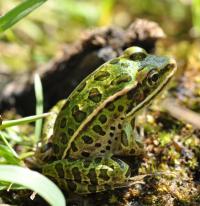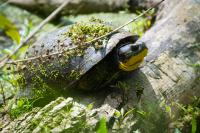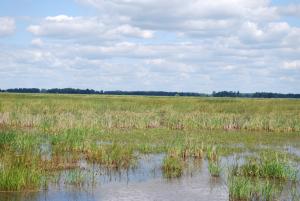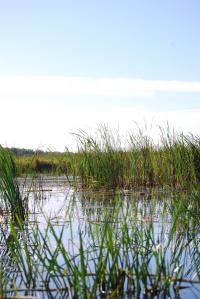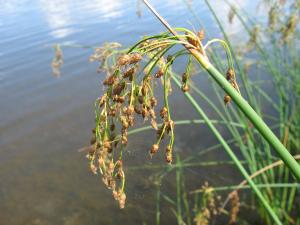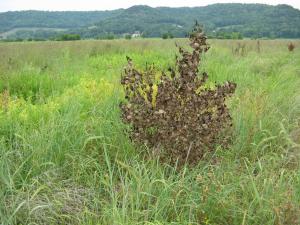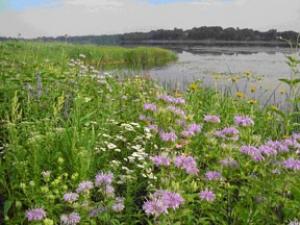What's Working for Conservation
Wetland Management
2025 Information
Grazing can be an effective management method for cattails. Most wildlife areas in Minnesota that lack grazing now have wetlands surrounded by cattails (a species that thrives in high nitrogen conditions. The dense cattails block the movement of ducklings from upland nests to water, as well as the movement of turtles, reptiles and amphibians. Archaeologist have found that bison kills by indigenous cultures maximized during drought periods, leading to the “Prairie Oasis” concept, where the grazing mammals focused on the only remaining green vegetation located at wetlands, and shallow water lakes. Grazing of these moist soil habitats resulted in massive nutrient export from the aquatic and terrestrial zones. Grazing of wetlands during droughts can benefit grazers, livestock, consumers, ducks, frogs, salamanders, turtles, and water quality. The grazing can mimic the once common wetland pulsing by muskrats, eating out all vegetation, described by Errington (1951, 1957) as the principle mechanism for wetland renewal and maintenance of ecosystem resilience (Stephen Thomforde).
2016 Information
Amphibian Habitat: The best wetland habitats for amphibians feature vegetation for concealment, foraging and egg-laying; and locations for hibernacula. While breeding requirements tend to vary, most amphibians lay their eggs in fishless aquatic habitats ranging from vernal pools to more permanent wetlands. Juveniles are usually aquatic. Some adults are terrestrial during parts of the year yet need to have access to water or moist soil to prevent desiccation because of their permeable skin.
Most amphibians hibernate during Minnesota’s winters. Species like northern leopard frog seek permanent waters to overwinter. Others like wood frog and gray treefrog burrow into leaf litter and rely on cryoprotectants to prevent their cells from rupturing when frozen. Still others like the American toad burrow in soft soils to get below the frost line.
The following are recommendations to minimize negative impacts to amphibians:
Avoid conducting dramatic drawdowns when egg and larval stages will be affected. Drawdowns during the active breeding season may strand amphibian eggs, larvae, and adults or lead to desiccation. Consider designing wetlands or encouraging flow toward small pools to prevent animals from being trapped in areas that will become dry. Gradual drawdowns over 30 days are preferred over rapid drawdowns.
Initiate fall drawdowns earlier. The ideal timing for fall drawdowns is after metamorphosis has occurred but before these animals are seeking overwintering sites. Reducing water levels in late fall can lead to direct mortality when animals freeze over winter due to a lack of refugia under ice, or winterkill because of a lack of oxygen with lowered water levels. Most should have metamorphosed by late summer. Drawdowns should reach their lowest level by 1 September for northern Minnesota and 15 September southern Minnesota and should stay dewatered through at least 1 December. This timing gives animals an opportunity to relocate to a suitable area for hibernation.
Avoid winter drawdowns. Winter drawdowns expose hibernating amphibians to freezing temperatures and make them susceptible to desiccation and freezing during a time when they are unable to escape. Late summer/early fall drawdowns are preferred, particularly if rare species are found in the vicinity.
Consider the status of nearby wetlands. When you plan a drawdown, consider whether the target wetland is the only suitable wetland for amphibians in the area. One or more satellite wetlands should have adequate winter water levels that extend into the next spring and summer to allow amphibians an alternate place to take refuge. Amphibians can then recolonize the drawdown wetland when water levels return. Depending on the objectives of the drawdown, also consider a partial drawdown to maintain some aquatic habitat in the area.
Be cognizant of indirect causes of mortality. During and immediately following a drawdown, many amphibians attempt to escape the area, increasing their vulnerability particularly when crossing roadways. Silt fencing (or other barriers) can be used to redirect amphibians toward more suitable habitat.
If you have Blanchard’ Cricket Frog (endangered) or any other rare species in the area or want more specific information for your site, contact a Nongame Wildlife Specialist or Carol Hall, Minnesota Biological Survey Herpetologist.
Authored by Christine Herwig – MN DNR Nongame Wildlife Program and Christopher E. Smith – MnDOT Office of Environmental Stewardship (formerly with Nongame Wildlife Program)
2013-2014 Information
Maintaining Plant Diversity: Maintaining wetlands in an early successional stage should promote higher plant diversity in both the basin and the wetland fringe, leading to a healthier wetland system overall. Maintaining wetlands in an early successional stage will require vigilance on the part of land managers, and treatments (herbicide, fire, grazing, discing etc.) in the range of every 3 – 5 years, just as maintaining prairie in an early successional stage does. As we continue to lose habitat we must either produce more wildlife on our managed areas, or watch as populations decline. Increasing wildlife production on the same acreage will require improving the quality of those habitats (Ray Norrgard, MN DNR).
Flooding Reed Canary Grass: Reed canary grass can be reduced by herbicide application or mowing followed by prolonged inundation if the flooding covers all remaining leaves and lasts for a full season. It can be difficult to find sites where there is suitable hydrology conditions for prolonged flooding (Dan Shaw, BWSR).
Hemi-marsh: The essence of hemi-marshes is the interspersion of shallow open water offering abundant food with emergent plants offering cover from the elements and predators; the same basic food and cover concepts of all good wildlife habitats. Unfortunately, there are many wetlands in Minnesota that meet the typical target of 1:1 ratio of emergent plants to open water that are of practically no value to wetland wildlife because of the dense growth pattern of invasive plants, turbidity that limits submergent plants, or deep water that allows fish to persist. Seasonal and annual changes are critical to maintaining the long-term habitat value of wetlands, as well as providing important interim habitat. Just a few examples include moist soil plants germinating from exposed mud flats during the growing season, dramatic reductions in undesirable fish during low water conditions in winter, and increases in invertebrates as dry margins are flooded. Wetland wildlife, from amphibians to waterfowl, require a diversity of wetlands to thrive throughout the year. In a healthy wetland landscape, the composition and density of wetland plants and invertebrates will differ between wetlands and between years. The most important driver behind this diversity is water level fluctuations. Recognizing that wetland diversity within a wetland habitat complex is important we must necessarily also recognize that hemi-marsh should not, and in fact cannot, be a universal management objective for all wetlands (Ray Norrgard, MN DNR).
Drawdowns: Water level changes are critical to the health and productivity of surface water wetlands and shallow lakes. Mimicking these changes with planned management drawdowns offers opportunities to optimize wetland habitat values. Too often, however, the classic Midwestern drawdown means simply eliminating surface water completely from the basin every 4 to 10 years to encourage perennial emergent plants. Certainly complete drawdowns are important, particularly if the management objective is increased density and distribution of emergent aquatic plants. However, there are significant benefits from partial drawdowns as well.
Shallow water concentrates food resources. This potentially increases the foraging efficiency of water birds by reducing the energy required to capture food. Wading birds, dabbling ducks and shorebirds capture food most efficiently in water depths of less than one foot. Shallow depths also increase the amount of light reaching rooted submergent plants, increasing their density and vigor (Ray Norrgard, MN DNR).
Vegetation for Waterfowl: Bulrush species tend to act as cool season plants, responding well to mudflats early in the growing season. Cattails, on the other hand, respond more like warm season plants with the greatest gains in germination and growth during mid to late summer. Lower water levels throughout the growing season benefit submergent wetland plants by increasing the available sunlight throughout the water column. Lower water levels also benefit foraging birds. Early to mid-summer is a critical time for fledgling survival and growth. Counteracting the stress of migration with abundant food sources is most important during spring and fall. Lower levels going into winter can help reduce undesirable fish (Ray Norrgard, MN DNR).
Water Level Management: There are three primary reasons for managing water levels in wetlands. The first is that most managers are working in highly modified watersheds affected by artificial drainage. Water moves through these watersheds faster, more continuously, and with more agricultural chemicals and nutrients than ever before. Second, invasive plant and animal species have compromised the natural ability of wetlands to thrive. Nonnative plants now dominate many wetlands. In addition, the increased connectivity within watersheds has allowed undesirable fish to negatively impact wetland habitat. Third, we have entered a period of weather events more extreme than those previously experienced in the history of management agencies (Ray Norrgard, MN DNR).
Cottonwood Control: A combination of methods can be effective at cottonwood control including foliar application, basal treatment, cut/treat, prescribed fire (while still under .5 in. stems and sufficient fuel) and in some cases late summer mowing. The best option will depend on timing, size of plants, and available fuel for burning.
2008-2012 Information
Reed Canary Grass Control: We are in the process of restoring a remnant sedge meadow (3,500 sq. ft.) along a lakeshore. It is located between two large >500 linear foot shoreland restoration segments. Pre-project, it was dominated by reed canary grass (>90% cover). Three square bulrush was evenly distributed, but plant height was unusually modest, and may have been the result of substantial competition from reed canary. Since 2004, we have used a combination of weed whipping flowers to prevent seed production, dormant overspray with an aquatic formulation of glyphosate, and spot treatment with glyphosate and sethoxydim (during dry periods). We have seen a dramatic reduction in reed canary grass cover and a substantial increase in three square bulrush abundance. In addition, numerous wetland forb species have become established, most likely from seed blowing in from adjacent restoration sites. We are generally pleased with the results and will continue to manage reed canary grass in this remnant wet meadow (Ramsey Washington Metro Watershed District).
Importance of Maintenance: A wetland creation on city property gave direction to the maintenance crew to mow the site periodically for weed control. The site was subsequently mowed every two weeks; now in year 5 the wetland and upland buffer are beautiful with no weeds or invasives. In contrast, a streamside BMP project in the same county was not mowed at all by the landowner and reed canary grass has overwhelmed the site. Bottom line – mowing and maintenance for the first bunch of years is critical and not just twice a year (Jyneen Thatcher, Washington Conservation District).
Monitoring: Monitoring to detect weed problems early. It is important to spot treat perennial weeds (reed canary grass, purple loosestrife etc.) as soon as detected to prevent their spread.
Water Level Management: It is very helpful to use water control structures when available to maintain target hydrology and to maximize growth of native vegetation and discourage upland weeds. They are also very helpful in drawing down wetlands for access to conduct invasive species management (Dan Shaw, BWSR).

